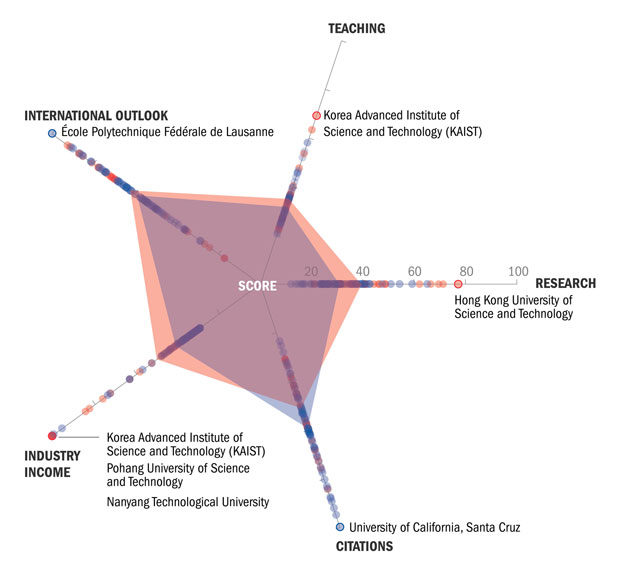The 100 Under 50 is the only Times Higher Education global ranking where the Asia-Pacific region outperforms the traditionally dominant Western powerhouses of North America and Europe, a fact that suggests a bright future for the rising Eastern powers. This spider graph shows the collective performance of the East (red) against the West (blue) in all five of our assessment categories: teaching (the learning environment); research (volume, income and reputation); citations (research influence); international outlook (staff, students and research); and industry income (innovation). Top performers are highlighted in each category.
Asia and Asia-Pacific
Universities from Australia, Hong Kong, Japan, Macau, Singapore, South Korea, Taiwan
The graph demonstrates that the East outperforms the West across four of the five assessment categories, with a collective overall score of 44 compared with the West’s 42.2. The Korea Advanced Institute of Science and Technology (KAIST), ranked third in the overall 100 Under 50 table, comes top for its teaching environment and shares pole position for knowledge transfer, as judged by the amount of income it attracts from industry.
Overall score: 44
Western Europe and North America
Universities from North America (Canada, United States) and Europe (Austria, Denmark, Finland, France, Germany, Greece, Italy, Netherlands, Norway, Portugal, Republic of Ireland, Spain, Sweden, Switzerland and United Kingdom)
While the East dominates the ranking, there remains one key area where Western institutions stand out: research impact. This category is judged by analysing research paper citations, an area where the prevalence of English language journals gives the anglophone world an advantage. The University of California, Santa Cruz takes top spot in this category.
Overall score: 42.2
